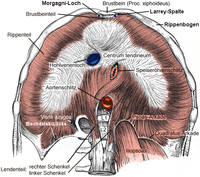
Photo from wikipedia
BACKGROUND AND PURPOSE: Congenital diaphragmatic hernia is associated with high mortality and morbidity, including evidence suggesting neurodevelopmental comorbidities after birth. The aim of this study was to document longitudinal changes… Click to show full abstract
BACKGROUND AND PURPOSE: Congenital diaphragmatic hernia is associated with high mortality and morbidity, including evidence suggesting neurodevelopmental comorbidities after birth. The aim of this study was to document longitudinal changes in brain biometry and the cortical folding pattern in fetuses with congenital diaphragmatic hernia compared with healthy fetuses. MATERIALS AND METHODS: This is a retrospective cohort study including fetuses with isolated congenital diaphragmatic hernia between January 2007 and May 2019, with at least 2 MR imaging examinations. For controls, we used images from fetuses who underwent MR imaging for an unrelated condition that did not compromise fetal brain development and fetuses from healthy pregnant women. Biometric measurements and 3D segmentations of brain structures were used as well as qualitative and quantitative grading of the supratentorial brain. Brain development was correlated with disease-severity markers. RESULTS: Forty-two fetuses were included, with a mean gestational age at first MR imaging of 28.0 (SD, 2.1) weeks and 33.2 (SD, 1.3) weeks at the second imaging. The mean gestational age in controls was 30.7 (SD, 4.2) weeks. At 28 weeks, fetuses with congenital diaphragmatic hernia had abnormal qualitative and quantitative maturation, more extra-axial fluid, and larger total skull volume. By 33 weeks, qualitative grading scores were still abnormal, but quantitative scoring was in the normal range. In contrast, the extra-axial fluid volume remained abnormal with increased ventricular volume. Normal brain parenchymal volumes were found. CONCLUSIONS: Brain development in fetuses with congenital diaphragmatic hernia around 28 weeks appears to be delayed. This feature is less prominent at 33 weeks. At this stage, there was also an increase in ventricular and extra-axial space volume.
Journal Title: American Journal of Neuroradiology
Year Published: 2023
Link to full text (if available)
Share on Social Media: Sign Up to like & get
recommendations!